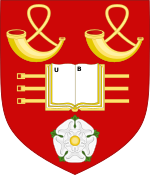Reconciliation (Josefina de Vasconcellos sculpture)

Reconciliation (originally named Reunion) is a sculpture by Josefina de Vasconcellos. Originally created in 1977 and entitled Reunion, it depicted a man and woman embracing each other ]. In May 1998 it was presented to University of Bradford as a memorial to the University's first Vice-Chancellor Professor Ted Edwards. De Vasconcellos said: "The sculpture was originally conceived in the aftermath of the War. Europe was in shock, people were stunned. I read in a newspaper about a woman who crossed Europe on foot to find her husband, and I was so moved that I made the sculpture. Then I thought that it wasn't only about the reunion of two people but hopefully a reunion of nations which had been fighting." Later it was taken for repairs to the sculptor's workshop, and renamed Reconciliation upon the request of the Peace Studies Department of the University. It was unveiled for the second time, under the new name, on de Vasconcellos 90th birthday, October 26, 1994. In 1995 (to mark the 50th anniversary of the end of World War II) bronze casts of this sculpture (as Reconciliation) were placed in the ruins of Coventry Cathedral and in the Hiroshima Peace Park in Japan. An additional cast can be found in the Stormont Estate in Belfast. To mark the opening of the rebuilt German Reichstag (parliament building) in 1999, another cast was placed as part of the Berlin Wall memorial.
Excerpt from the Wikipedia article Reconciliation (Josefina de Vasconcellos sculpture) (License: CC BY-SA 3.0, Authors, Images).Reconciliation (Josefina de Vasconcellos sculpture)
Longside Lane, Bradford Great Horton
Geographical coordinates (GPS) Address Nearby Places Show on map
Geographical coordinates (GPS)
| Latitude | Longitude |
|---|---|
| N 53.7909 ° | E -1.7672 ° |
Address
University of Bradford
Longside Lane
BD7 1SA Bradford, Great Horton
England, United Kingdom
Open on Google Maps








